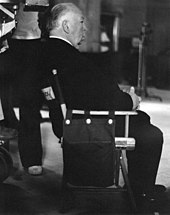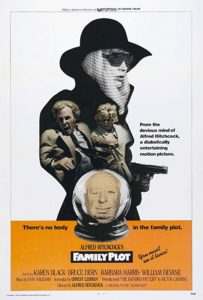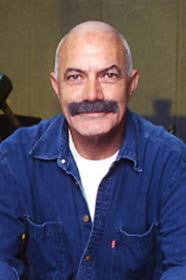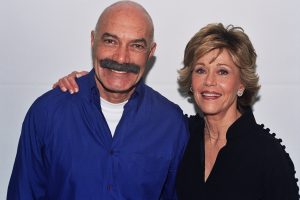Family Plot, Hitchcock’s fifty-third–and last feature (he died in 1980)–is unfortunately much misunderstood and still underappreciated.
Grade: B (*** out of *****)
A film of modest goals, Family Plot admittedly lacks the dramatic urgency and striking visual style of Hitchcock’s previous films.
Harsh critics have charged that the movie is too lightweight and whimsical, precluding viewers’ emotional identification with any of the characters, male or female.
But judged on its own terms, Family Plot is a nicely constructed, self-reflexive mystery-comedy-family tale, which was never intended to be a suspenseful thriller.
As such, it points to a new direction in the maestro’s career toward a movie that is more relaxed, and not based on a single star (or few stars).
The sly tale features intricate parallel plots (in this case, in more senses than one), and boasts a complex storytelling that revolves around a large ensemble.
Read about the making of Family Plot
https://emanuellevy.com/wp-admin/post.php?post=268973&action=edit
It is defined by an ambiguous but satisfying ending that could be interpreted in different ways.
No surprisingly, the scribe is Ernest Lehman, who had earlier penned another brilliant film, “North by Northwest,” here loosely adapting to the screen the novel “The Rainbird Pattern” by Victor Canning.
The tale is multi-generational in narrative structure, and multi-national in casting, blending the conventions of various genres and mixing American and British players, younger and older thespians, such as the the legendary vet actress Cathleen Nesbitt.
Nesbitt plays Miss Julia Rainbird, an old, rich woman who tries to locate her long-lost, sole surviving heir-nephew.
Early on, she declares, “I am 78 years old and I want to go to my grave with calm conscience” (Hitchcock was almost the same age when he made this picture).
Read about the Making of Family Plot
https://emanuellevy.com/wp-admin/post.php?post=268973&action=edit
In a parallel plot, we are introduced to two American actors, Barbara Harris, who plays a spiritualist called Blanche (she’s actually a phony medium), and Bruce Dern, as her boyfriend, a cab-driver named George Lumley, who is actually an aspiring actor.
In another subplot, we meet another bizarre couple, Arthur Adamson (William Devane), a jewelry merchant, and his girlfriend Fran (Karen Black), a duo engaged in kidnapping and robberies.
Adamson’s latest kidnap victim is shown enjoying a meal in the underground room, where his captors keep him (Some critics claimed that the imprisonment in this film is taken too lightly).
In quite an ingenious way, the paths of the two couples crisscross, and it turns out that Adamson is really the missing nephew.
The film’s title point to numerous plotting. Each of the character had at some point engaged in a deviant plotting. Julia Rainbird had persuaded her sister Harriet to give up her illegit son. As a child, Adamson (aka as Edward Shoebridge) had plotted to kill his adoptive parents, Harry and Sadie, who are now buried in a family plot.
The film lacks a linear plot, which proceeds by fits and starts, leaving loose ends along the way. We never learn about the circumstances of Adamson’s birth, or about his motives to kill his adopters. The auto mechanic who helped him kill his adoptive parents is introduced with wife who grieves at his death.
Theft and Sexuality
Some recurring Hitchcock themes run through the narrative. Like “To Catch a Thief” and “Marnie,” there is a connection between theft and sexuality. Except there is greater self-consciousness about it: Fran feels sexually aroused when engaging in stealing and kidnapping.
The pursuit of a missing individual is an issue that had concerned Hitchcock in a dozen films, going back to such 1930s British gems as “The 39 Steps” and “The Lady Vanishes.” Except that here the missing man, Adamson, is a kidnapper himself, specializing in kidnapping upper class men and professionals, whom he hides in his basement.
With no exception, all the characters assume false identities, fake names, and appearances, heavily engaged in role-playing.
Stylistically, the movie is marked by symmetry. The first and last images are the same: Close-up of Blanche at night.
What adds to the intricacy, dark humor, and irony is the fact that many scenes are set in the cemetery.
Overall, “Family Plot” reveals Hitchcock’s growing awareness that the movie industry, its core audiences, and tastes have changed. Indeed, the star system, the desirable tight narrative focus, the sharp emotional conflicts, and clearer resolutions, all conventions of his earlier films, can no longer apply to the movies of the new era.
Structurally loose but thematically dense, ”Family Plot” shows that Hitchcock was in the process of readjustment to a new type of cinema, one that’s more flexible, more dynamic, and less star-oriented.
Female-Dominated Tale
By and large, the tale’s female roles are more interesting. There are four women: Julia, the rich elderly woman, troubled by nightmares; Blanche, the spiritualist; Fran, a friend of Adamson who kidnaps; and Mrs. Maloney, a woman trapped by crime of her husband, and too involved to be objective.
While Julia sets the plot in motion, she then declines in significance, failing to disappear at the end.
Hitchcock’s Cameo
The director’s signature cameo appearance: the familiar silhouette is seen through a translucent window, with the word “death” superimposed.

Ending but No Closure?
In the end, the two sets of characters conjoin, and the plot nominally closes in a contrived mode, but there is no real sense of closure, and thus no real sense of gratification.
In the film’s final (jokey) shot, Blanche winks directly at the camera (namely, the viewers). And since it became Hitchcock’s last film, inevitably we read more into it–as if it were his farewell to his loyal audience of five decades!
Commercial Appeal:
Made on a budget of $4.5 million, Family Plot was moderately popular at the box office, generating $13 million.
Cast
Karen Black as Fran
Bruce Dern as George Lumley
Barbara Harris as Blanche Tyler
William Devane as Arthur Adamson/Edward Shoebridge
Cathleen Nesbitt as Julia Rainbird
Ed Lauter as Joseph P. Maloney
Katherine Helmond as Mrs. Maloney
Warren J. Kemmerling as Grandison
Nicholas Colasanto as Victor Constantine
Edith Atwater as Mrs. Clay
William Prince as Bishop Wood
Marge Redmond as Vera Hannagan
John Lehne as Andy Bush
Charles Tyner as Wheeler
Alexander Lockwood as Parson
Martin West as Sanger
Elisabeth Brooks as Woman in cafe with priest
Carl Byrd as Lieutenant Peterson (Uncredited)
Credits
Produced and directed by Alfred Hitchcock
Screenplay: Ernst Lehman, from the novel “The Rainbird Pattern” by Victor Canning
Camera; Leonard J. South
Production designer: Henry Bumstead
Set Decoration: James W. Payne
Editor: J. Terry Williams
Sound: James Alexander and Robert L. Hoyt
Costumes: Edith Head
Music: John Williams
F/X: Albert Whitlock
Release date: April 9, 1976
Running time: 120 minutes
Budget $4.5 million
Box office $13 million











